Birdfinding.info ⇒ A localized Puerto Rican endemic that is most conveniently found in the town of La Parguera, particularly around the Parador Villa Parguera. Also found reliably at Boquerón and Cabo Rojo National Wildlife Refuges.
Yellow-shouldered Blackbird
Agelaius xanthomus
Endemic to Puerto Rico, where it is locally common along the southwestern coast, and Mona Island, where it is fairly numerous. Formerly widespread on Puerto Rico and Vieques (where last reported in 1978), it appears to be rebounding steadily from a steep decline that brought it close to extinction in the 1980s. (See Notes on Conservation History, below.)
Breeds colonially in mangroves and some adjacent upland areas along Puerto Rico’s southern coast, mainly in the southwest from Boquerón to La Parguera, and separately in the southeast between Salinas and Guayama. Much smaller numbers nest farther inland in the southwest—including the town of San Germán. Recent sightings suggest that it may be in the process of recolonizing former breeding areas north along the western coast to Rincón and along the eastern coast near Ceiba and Fajardo.
Forages mostly near its breeding areas in towns, fields, gardens, and scrub. In the non-breeding season, mostly from September to March, occurs somewhat more widely, and could turn up almost anywhere in the coastal plain of Puerto Rico.
Monensis nests mainly on steep seaside cliffs on Mona Island. During the breeding season about 5-10% of the subspecies migrate across three miles of open ocean to nest on the islet Monito. In the non-breeding season, the Monito breeders return to Mona and the whole subspecies aggregates into a few large flocks that reportedly roost in caves.
Identification
Adults of both sexes are black overall with bright yellow epaulets. The epaulets are sometimes concealed when the wing is folded, but are always visible in flight.
Immatures are similar to adults, but duller, with a smaller, less distinct epaulet.

Yellow-shouldered Blackbird, showing full yellow epaulet. (La Parguera, Puerto Rico; May 15, 2010.) © Michael J. Morel
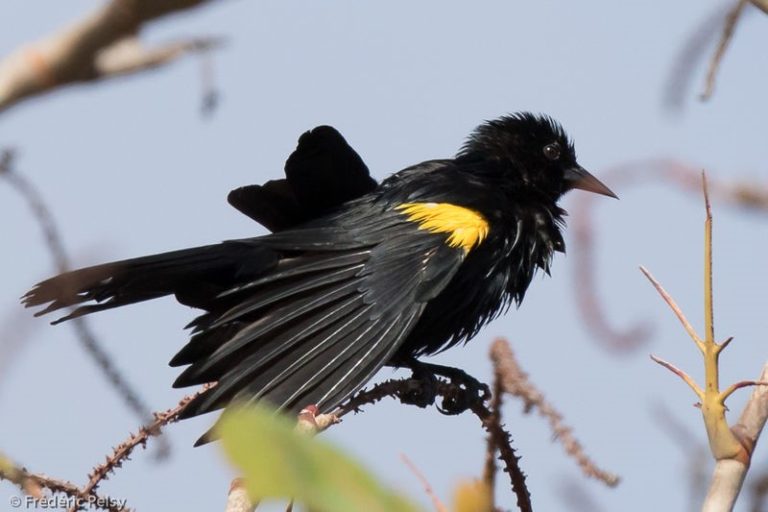
Yellow-shouldered Blackbird. (La Parguera, Puerto Rico; March 23, 2017.) © Frédéric Pelsey
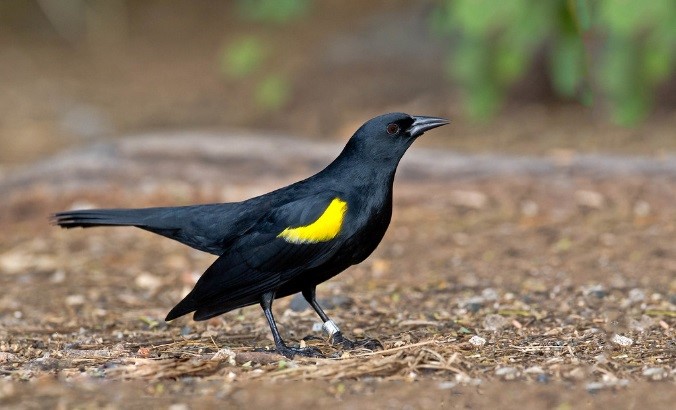
Yellow-shouldered Blackbird. (Puerto Rico; December 18, 2011.) © Canter Photography
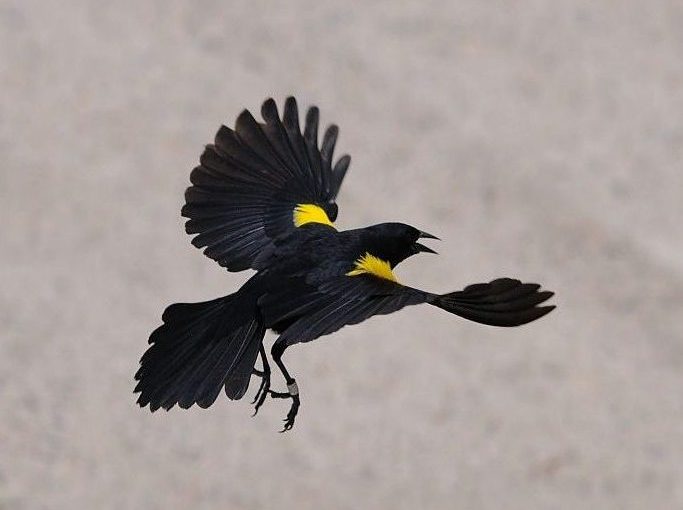
Yellow-shouldered Blackbird. (La Parguera, Puerto Rico; May 15, 2010.) © Michael J. Morel
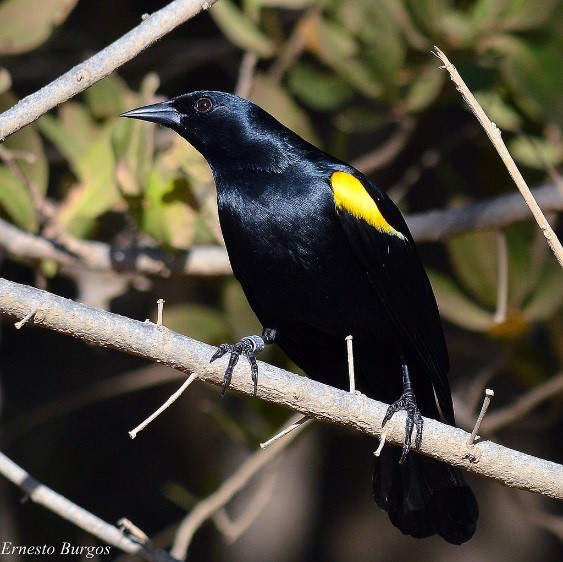
Yellow-shouldered Blackbird. (Cabo Rojo, Puerto Rico; February 22, 2014.) © Ernesto Burgos
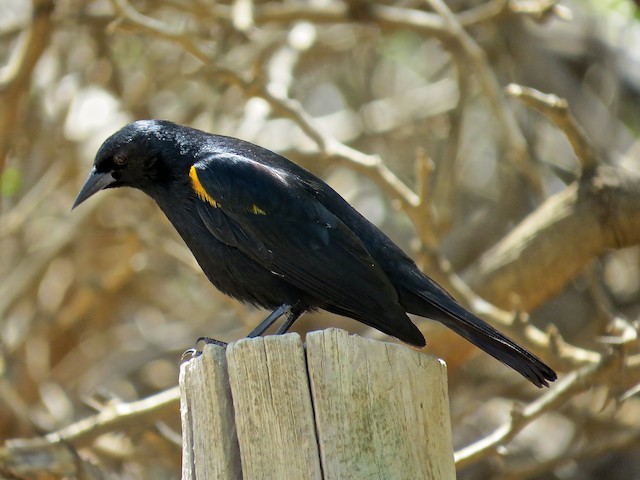
Yellow-shouldered Blackbird, with yellow epaulets mostly concealed. (Cabo Rojo National Wildlife Refuge, Puerto Rico; March 18, 2016.) © Kenneth Pinnow

Yellow-shouldered Blackbird. (La Parguera, Puerto Rico; March 23, 2015.) © Tom Johnson

Yellow-shouldered Blackbird, showing full yellow epaulets. (La Parguera, Puerto Rico; May 15, 2010.) © Michael J. Morel

Yellow-shouldered Blackbird, showing only a sliver of yellow on the shoulder. (La Parguera, Puerto Rico; March 27, 2012.) © John Crosby

Yellow-shouldered Blackbird, showing only a minuscule trace of yellow on the shoulder. (Cabo Rojo, Puerto Rico; May 27, 2017.) © Michael Todd
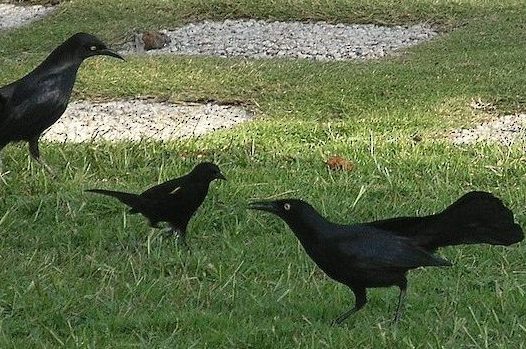
Yellow-shouldered Blackbird, between much larger Greater Antillean Grackles. (La Parguera, Puerto Rico; February 6, 2006.) © Tim Lenz
Highly gregarious, typically found in loose flocks. Usually forages on the ground, often in mixed flocks with Shiny Cowbirds and Greater Antillean Grackles.
Monensis differs from the nominate subspecies in having a whitish fringe on its epaulets—but this difference is subtle (barely detectable in these photos).
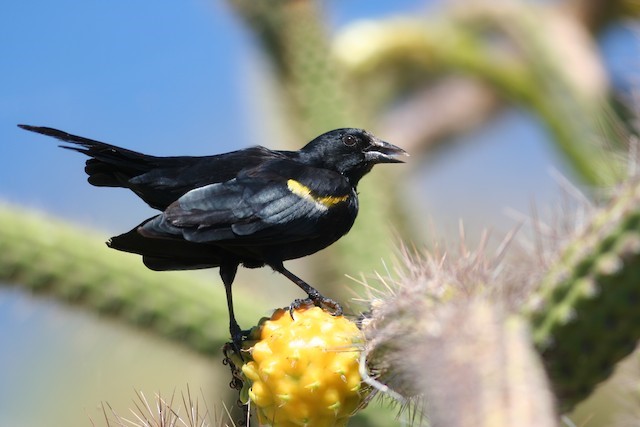
Yellow-shouldered Blackbird, A. x. monensis. (Isla Monito, Puerto Rico; September 11, 2008.) © Alcides L. Morales Pérez

Yellow-shouldered Blackbird, A. x. monensis. (Mona Island, Puerto Rico; April 21, 2009.) © Alcides L. Morales Pérez
Voice. Song is described as “a nasal rasp.” Otherwise gives a variety of contacts calls, both single notes and chatter:
Notes
Polytypic species consisting of two recognized subspecies: xanthomus and monensis.
IUCN Red List Status: Endangered.
Conservation History. In the mid-1800s, the Yellow-shouldered Blackbird was described as “excessively abundant” around San Juan and thrived in various habitats across Puerto Rico and Vieques. A combination of human persecution as a perceived agricultural pest, nest predation by rats and mongoose, and brood parasitism by Shiny Cowbirds drastically reduced its numbers to a low of approximately 300 in 1982, almost all in the far southwest, and none on Vieques. Conservation efforts, including cowbird control measures, helped stem the decline and have resulted in significant increases—to approximately 1,000 birds in recent years—although its numbers continue to fluctuate significantly from year to year.
In the 1980s and 90s, three breeding populations remained on Puerto Rico, all nesting colonially on mangrove islands. By far the largest occupied several sites along the southwest coast. A second group remained in the southeast in the Jobos Bay National Estuarine Research Reserve between Salinas and Guayama. In 2012, the southwestern population was estimated at 650, and the Jobos Bay population was approximately 100.
The third Puerto Rican population was a small flock that nested at the eastern tip of the island in the Ceiba Natural Reserve State Forest (formerly part of Roosevelt Roads Naval Station), but reportedly vanished in the late 1990s. Recent sightings around Ceiba and Fajardo suggest that the species is recolonizing that area, or that this tiny population never disappeared entirely.
On Mona Island, censuses of known roosting sites during the 1990s counted between 153 and 310 individuals, and the overall population estimate was 400. Counts on Monito during the breeding season have been approximately 25 birds (i.e., about ten to twelve nesting pairs).
Although the remnant populations of Yellow-shouldered Blackbird have peculiar nesting habits that make the species as a whole appear highly specialized, this appears to be a recent development that arose because its other breeding strategies proved more vulnerable to predation, parasitism, and human interference. Apart from being a social breeder, the Yellow-shouldered Blackbird is not as limited as its small range suggests. It has recently shown a high tolerance for human development, which may provide a path to long-term recovery.
References
eBird. 2018. eBird: An online database of bird distribution and abundance. Cornell Lab of Ornithology, Ithaca, N.Y. http://www.ebird.org. (Accessed October 11, 2018.)
BirdLife International. 2016. Agelaius xanthomus. The IUCN Red List of Threatened Species 2016: e.T22724209A94854739. http://dx.doi.org/10.2305/IUCN.UK.2016-3.RLTS.T22724209A94854739.en. (Accessed October 18, 2017.)
Jaramillo, A., and P. Burke. 1999. New World Blackbirds: The Icterids. Princeton University Press, Princeton, N.J.
Post, W. 2011. Yellow-shouldered Blackbird (Agelaius xanthomus), version 1.0. In Neotropical Birds Online (T.S. Schulenberg, ed.). Cornell Lab of Ornithology, Ithaca, N.Y. https://doi.org/10.2173/nb.yesbla1.01.
Raffaele, H., J. Wiley, O. Garrido, A. Keith, and J. Raffaele. 1998. A Guide to the Birds of the West Indies. Princeton University Press, Princeton, N.J.
U.S. Fish and Wildlife Service. 1996. Yellow-shouldered Blackbird (Agelaius xanthomus) Revised Recovery Plan. https://ecos.fws.gov/docs/recovery_plans/1996/961112a.pdf.
Ventura, B., Jr. 1945. A new form of Agelaius from Mona Island, Puerto Rico. The Auk 62: 299-300.
